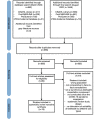Visit Types in Primary Care With Telehealth Use During the COVID-19 Pandemic: Systematic Review
- PMID: 36265039
- PMCID: PMC9745650
- DOI: 10.2196/40469
Visit Types in Primary Care With Telehealth Use During the COVID-19 Pandemic: Systematic Review
Abstract
Background: Telehealth was rapidly incorporated into primary care during the COVID-19 pandemic. However, there is limited evidence on which primary care visits used telehealth.
Objective: The objective of this study was to conduct a systematic review to assess what visit types in primary care with use of telehealth during the COVID-19 pandemic were reported; for each visit type identified in primary care, under what circumstances telehealth was suitable; and reported benefits and drawbacks of using telehealth in primary care during the COVID-19 pandemic.
Methods: This study was a systematic review using narrative synthesis. Studies were obtained from four databases (Ovid [MEDLINE], CINAHL Complete, PDQ-Evidence, and ProQuest) and gray literature (NSW Health, Royal Australian College of General Practitioners guidelines, and World Health Organization guidelines). In total, 3 independent reviewers screened studies featuring telehealth use during the COVID-19 pandemic in primary care. Levels of evidence were assessed according to the Grading of Recommendations Assessment, Development, and Evaluation. Critical appraisal was conducted using the Mixed Methods Appraisal Tool. Benefits and drawbacks of telehealth were assessed according to the National Quality Forum Telehealth Framework.
Results: A total of 19 studies, predominately cross-sectional surveys or interviews (13/19, 68%), were included. Seven primary care visit types were identified: chronic condition management (17/19, 89%), existing patients (17/19, 89%), medication management (17/19, 89%), new patients (16/19, 84%), mental health/behavioral management (15/19, 79%), post-test result follow-up (14/19, 74%), and postdischarge follow-up (7/19, 37%). Benefits and drawbacks of telehealth were reported across all visit types, with chronic condition management being one of the visits reporting the greatest use because of a pre-existing patient-provider relationship, established diagnosis, and lack of complex physical examinations. Both patients and clinicians reported benefits of telehealth, including improved convenience, focused discussions, and continuity of care despite social distancing. Reported drawbacks included technical barriers, impersonal interactions, and semi-established reimbursement models.
Conclusions: Telehealth was used for different visit types during the COVID-19 pandemic in primary care, with most visits for chronic condition management, existing patients, and medication management. Further research is required to validate our findings and explore the long-term impact of hybrid models of care for different visit types in primary care.
Trial registration: PROSPERO CRD42022312202; https://tinyurl.com/5n82znf4.
Keywords: COVID-19; eHealth; general practitioners; primary care; remote consultation; telehealth; telemedicine; video consultation.
©Kanesha Ward, Sanjyot Vagholkar, Fareeya Sakur, Neha Nafees Khatri, Annie Y S Lau. Originally published in JMIR Medical Informatics (https://medinform.jmir.org), 28.11.2022.
Conflict of interest statement
Conflicts of Interest: None declared.
Figures
Similar articles
-
Beyond the black stump: rapid reviews of health research issues affecting regional, rural and remote Australia.Med J Aust. 2020 Dec;213 Suppl 11:S3-S32.e1. doi: 10.5694/mja2.50881. Med J Aust. 2020. PMID: 33314144
-
Satisfaction With Telehealth Services Compared With Nontelehealth Services Among Pediatric Patients and Their Caregivers: Systematic Review of the Literature.JMIR Pediatr Parent. 2023 Apr 27;6:e41554. doi: 10.2196/41554. JMIR Pediatr Parent. 2023. PMID: 37000504 Free PMC article. Review.
-
The Impact of Telemedicine Adoption on a Multidisciplinary Bariatric Surgery Practice During the COVID-19 Pandemic.Ann Surg. 2020 Dec;272(6):e306-e310. doi: 10.1097/SLA.0000000000004391. Ann Surg. 2020. PMID: 33086326 Free PMC article.
-
Promoting and supporting self-management for adults living in the community with physical chronic illness: A systematic review of the effectiveness and meaningfulness of the patient-practitioner encounter.JBI Libr Syst Rev. 2009;7(13):492-582. doi: 10.11124/01938924-200907130-00001. JBI Libr Syst Rev. 2009. PMID: 27819974
-
Telehealth in Urology: A Systematic Review of the Literature. How Much Can Telemedicine Be Useful During and After the COVID-19 Pandemic?Eur Urol. 2020 Dec;78(6):786-811. doi: 10.1016/j.eururo.2020.06.025. Epub 2020 Jun 18. Eur Urol. 2020. PMID: 32616405 Free PMC article.
Cited by
-
Considerations and experiences with healthcare-seeking during the first COVID-19 lockdown in Denmark.Scand J Prim Health Care. 2025 Jun;43(2):434-447. doi: 10.1080/02813432.2025.2452924. Epub 2025 Jan 20. Scand J Prim Health Care. 2025. PMID: 39831697 Free PMC article.
-
Comparison of Short-Term Health Care Utilization Between Telemedicine-Delivered vs In-Person Care Visits for Heart Failure.JACC Adv. 2024 May 2;3(6):100969. doi: 10.1016/j.jacadv.2024.100969. eCollection 2024 Jun. JACC Adv. 2024. PMID: 38938856 Free PMC article.
-
eVisits to primary care and subsequent health care contacts: a register-based study.BMC Prim Care. 2024 Aug 12;25(1):297. doi: 10.1186/s12875-024-02541-y. BMC Prim Care. 2024. PMID: 39135150 Free PMC article.
-
Exploring the Use of Mobile Health for the Rehabilitation of Long COVID Patients: A Scoping Review.Healthcare (Basel). 2024 Feb 10;12(4):451. doi: 10.3390/healthcare12040451. Healthcare (Basel). 2024. PMID: 38391826 Free PMC article.
-
Contextual factors influencing the use of digital health by patients and physicians in primary care: a scoping review protocol.BMJ Open. 2024 Dec 20;14(12):e088169. doi: 10.1136/bmjopen-2024-088169. BMJ Open. 2024. PMID: 39806600 Free PMC article.
References
-
- Johnsen TM, Norberg BL, Kristiansen E, Zanaboni P, Austad B, Krogh FH, Getz L. Suitability of video consultations during the COVID-19 pandemic lockdown: cross-sectional survey among Norwegian general practitioners. J Med Internet Res. 2021 Feb 08;23(2):e26433. doi: 10.2196/26433. https://www.jmir.org/2021/2/e26433/ v23i2e26433 - DOI - PMC - PubMed
-
- Douglas M, Katikireddi SV, Taulbut M, McKee M, McCartney G. Mitigating the wider health effects of covid-19 pandemic response. BMJ. 2020 Apr 27;369:m1557. doi: 10.1136/bmj.m1557. http://www.bmj.com/lookup/pmidlookup?view=long&pmid=32341002 - DOI - PMC - PubMed
-
- Nickelson DW. Telehealth and the evolving health care system: strategic opportunities for professional psychology. Prof Psychol Res Pract. 1998 Dec;29(6):527–35. doi: 10.1037/0735-7028.29.6.527. - DOI
Publication types
LinkOut - more resources
Full Text Sources


